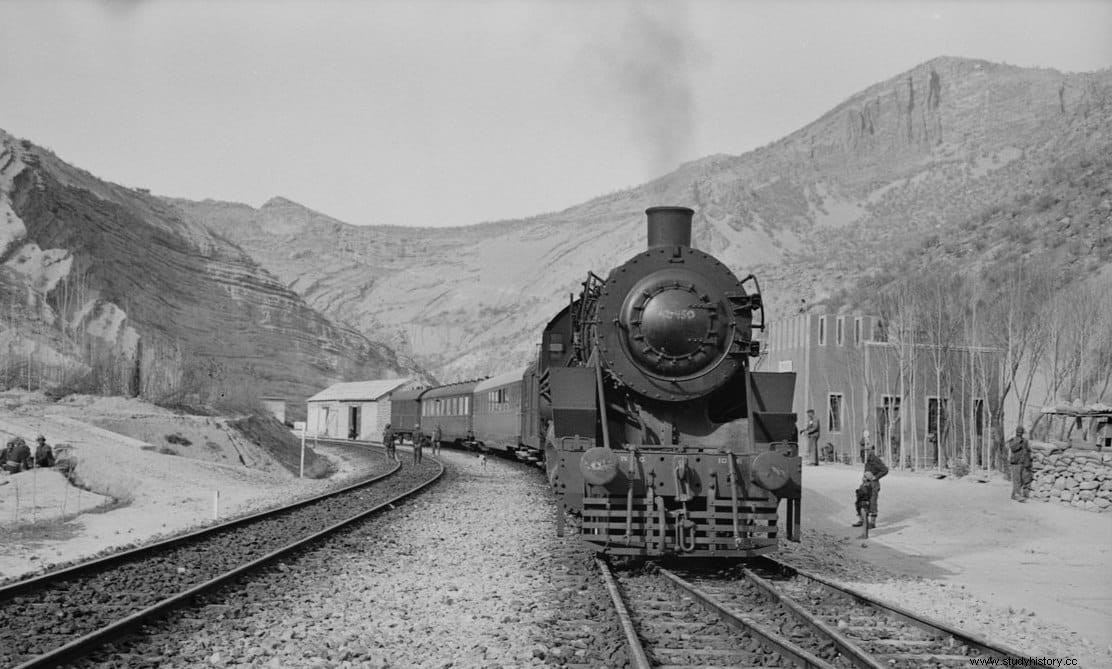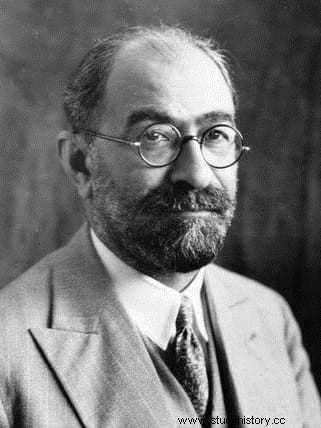Since the 1930s, the use of cars and trucks had become so widespread that oil became one of the sources of wealth for the economy and, consequently, when the Second World War broke out, it was a fundamental strategic factor for almost all types of vehicles, whether land, air or sea.
This need to ensure the supply of fuel gave rise to more than one campaign by both contending sides and one of the most curious, as it was a precedent for something that would be repeated decades later, was Operation Countenance , which led a combined British and Soviet army to invade Iran to gain access to its oil fields and maintain a supply line to the USSR.
The United Kingdom and the Soviet Union were allies since Germany started Operation Barbarossa attacking territory of the latter, and both viewed with concern the possibility that an officially neutral but Axis-friendly Iran would allow the Axis access to oil produced in Abadan, a region at the mouth of the Euphrates that has been rich in oil since its discovery in 1909 and whose exploitation - about eight million tons in 1940 - was in the hands of an Anglo-Iranian company.

On the other hand, the trans-Iranian railway, which linked the Persian Gulf with the Caspian Sea, had become the only alternative for shipments of material that the Allies sent to the USSR, given the danger that German submarines posed for a maritime transport and the limitations that arose before the occupation by land. A double reason, then, to set eyes on Iranian soil, aggravated by a third:Moscow's aspiration to incorporate some of its regions, as part of Azerbaijan and Turkmenistan.
Thus, although Shah Reza Khan did not support Hitler's anti-Semitic policy (Iranian embassies in Europe saved thousands of Jews), he was a declared admirer of the regime; after all, during the pre-war years, the country had modernized (it even changed its name; before it was Persia) thanks to the presence of numerous Teutonic technicians and from 1939 Germany was its main trading partner. Likewise, he had distanced himself from the United Kingdom since in 1931 he canceled the so-called D'Arcy Concession, which delivered 90% of the profits from Abadan's oil to London.

Reza Khan therefore came under pressure, and in the summer of 1941 he was required to expel from Iran the approximately 1,000 German residents whom he believed played an important role in strategic positions.
Tehran refused and Germanophile demonstrations began to take place, although the government tried to maintain a certain balance, aware that numerous British troops, known as Iraq Command, were stationed in neighboring Iraq. (orIraqforce ). But the matter of the Teutons on Iranian soil became casus belli and on August 25 the invasion began.
He did it precisely in Abadan, whose port -with his ships- was bombarded by the destroyer HMS Shoreham to cover the amphibious and paratrooper landing of two battalions of the 24th Indian Brigade who seized the oil refinery facility that same afternoon while another combined Soviet, British and Indian force protected by the Royal Navy occupied another port city without much resistance, Bandar-e-Shahpur, important because the aforementioned Trans-Iranian railway ended -or began- there.

At the same time, the RAF attacked bases and communications and other Indian battalions entered Iran from various points, conquering one town after another with the dual objective of taking the Naft-i-Shah oil fields and securing the Pai Tak pass, which guaranteed that the railway corridor would not be interrupted. It was a more difficult operation, due to the mountainous terrain.
Soviet forces also penetrated from Transcaucasia and Turkmenistan, seizing Iranian Azerbaijan and moving south to link up with their allies in Sanandaj and Qazvin. In just two days, all the objectives were met and leaflets were dropped on an isolated Tehran urging surrender, so that the Shah, who had unsuccessfully asked the US to intercede, had to parley on August 29.
The Iraqforce had been renamed Paiforce and consisted of three divisions and two Indian infantry brigades plus a British armored cavalry brigade; in total about 200,000 men with tanks, artillery and aviation that were under the command of Lieutenant General Edward Quinan. The Soviets sent three armies (44th, 47th and 53rd), led by General Dmitry Timofeyevich Kozlov, numbering a thousand tanks; they only encountered real opposition in the Bandar Pahlavi port on the Caspian Sea, but the air force put an end to it.

Opposite, Iran mobilized nine infantry divisions, two of them motorized (with obsolete French tanks and fifty panzers Germans), but without an air force and with little training, since until then the Shah had only used his troops against the people, in tasks of repression, and furthermore his modernization process was halfway through. The allied attack was so sudden that there was no time to organize an effective defense, not to mention that the Shah did not want to follow the recommendation of his generals to destroy the road network, which had cost so much to do.
The collapse was total:the Iranian commanders and officers actually sympathized with the British, the soldiers fled their posts due to the fame of the Red Army and any plan was impossible, so Reza Khan - who was about to beat the chief to death of his armed forces, the prince saving him in exchange for sending him to prison - had to parley on August 29 after evacuating his family to Isfahan.

After Prime Minister Ali Mansur was dismissed for being pro-British, his replacement, Mohammad Ali Foroughi, assumed the role of surrender negotiator. Interestingly, Foroughi was a reprisaled ex-oppositionist whose son had been shot, so he was presented with an excellent opportunity to take revenge:in exchange for the invaders not entering the capital, he would expel all citizens of Axis countries (Germans, Italians, Romanians and Hungarians), handing over their diplomats to the British and Soviets (which for many of them meant a certain prison sentence or worse).
The latter did not come to pass because the Shah quickly organized his escape, but this cost him the entry into Tehran of the Red Army in mid-September, causing his disbandment and consequent abdication; he would die in exile, in South Africa, before the end of the war.
The British considered restoring the Qajar dynasty, which was favorable to them, but there was a problem:its representative, Hamid Hassan Mirza, had grown up in Britain and did not speak Persian. So in the end it was Reza Khan's son who came to the throne; his name was Mohammad Reza Pahlavi and he would remain in power until his overthrow by the Ayatollah Revolution led by Khomeini in 1979.
Complying with the agreement, the invading troops left the capital on October 17 but divided up the country, with the northern half controlled by the Soviet Union and the other by the United Kingdom; yes, with the commitment to leave six months after the end of the war. In return, the Shah declared war on Germany in September 1943, which endorsed him to be admitted to the newly created UN and go from being an occupied country to one more ally. All this allowed, through a treaty, to use the Persian corridor to send nearly five million tons of material to the Soviets, in addition to opening supply routes to the British army destined for the Middle East.

The Germans tried to disrupt that flow of transports and create a resistance movement with three attempts. The first, the financing of a fascist organization called Melnune Iran that it lacked real strength as it did not have the support of the Iranian government or the majority of the population.
The second was the Operation Francois , designed by the Abwehr and developed in the summer of 1943 by paratroopers from the 502nd Jäger SS Battalion led by Otto Skorzeny (who would soon become famous for rescuing Mussolini from the Gran Sasso). It consisted of sabotaging the convoys, taking the town of Qashqai as the point of operations, but it failed due to insufficient forces and equipment.
The third was the Operation Long Jump , whose objective was to attack the three great allied leaders, Roosevelt, Stalin and Churchill, during the Tehran Conference, in which they met for the second time (in fact it was an epilogue of the first, held in Cairo a few days before) . Again Skorzeny was entrusted with the mission and again it proved impossible when it was discovered and dismantled by Soviet agents under the command of a young nineteen-year-old officer named Guevork Vartanián.

The Tehran Conference had been convened to complete the previous one, fulfilling the collaborative attitude of the Shah and finishing off pending issues such as the opening of a second front in Western Europe, the renewal of the commitment to territorial respect for the host country and the sending of economic aid to its recovery, since, when its infrastructures were destroyed and the crops lost, the scarcity (including an inflation of 450%) had caused popular unrest, resolved with martial law -which ended with several deaths-.
That year also saw the arrival of a sizeable US contingent in the Persian corridor, with more than a third of the material sent to the Soviet Union (and Iran itself) under the Lend-Lease Act passing through that route. , the Lending and Leasing Law that authorized the shipment of weapons, oil and food to allied countries in exchange for bases there and which was maintained until August 1945. The North American presence also calmed the spirits of those who did not trust the Anglo-Soviet word for leaving when peace comes.

But it was a naive trust. As we said before, the USSR coveted Azerbaijan and Kurdistan, areas of northeastern Iran, so during the occupation it organized the Tudeh , a local communist party that was busy spreading pre-revolutionary propaganda among the tenant class against the arbabs (landowners), giving rise to violent clashes from which, two months after the end of World War II, the People's Republic of Azerbaijan emerged with the support of Moscow.
Shortly after, the Kurdish People's Republic was also born without the Iranians being able to prevent it because the new countries were protected by the Red Army.
On March 2, 1946, six months after the end of the war, the British fulfilled the agreement and began the march on Iran. The Soviets, on the other hand, did not leave until May, after Iran filed a complaint with the UN Security Committee, which did nothing. One and the other continued to share Iranian oil.
